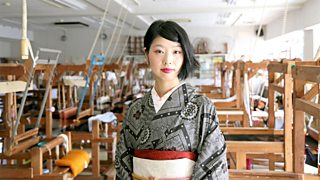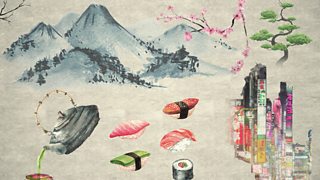
Ryan Gander: The Idea of Japan
Artist Ryan Gander explores Japanese visual culture through symbols including the Geisha, Samurai and cherry blossom to find what they tell about their past, present and future.
Ryan Gander OBE is a leading conceptual artist. He creates artworks full of symbolic meaning – images, sculpture, installations and films that may appear to be about one thing, but contain further messages for the thoughtful. And this, he believes, is why he is “big in Japan.” Ryan believes he is appreciated there because the country has a highly sophisticated visual culture, expressed through images and symbols that broadcast cultural messages to the world, as well as to the Japanese themselves. The Geisha and the Samurai are obvious examples; bullet train, tattoo art, and Tokyo street style are less so. The exploration of these signs and symbols takes him six thousand miles east of his Suffolk studio, to investigate how Japanese visual culture is closely linked to a special relationship with time, as the country’s past and future inform its present tense.
The journey begins at Tokyo and the famous Scramble Crossing at Shibuya, where crowds race across a huge junction. It looks like chaos, but it’s actually an affirmation of an unwritten Japanese code of civic conduct and an underlining of the power of Buddhism, and the state religion, Shinto. Visiting a series of temples Ryan investigates the teachings of Shinto, a word which means Way of the Gods and demands civic responsibility of citizens who have always lived cheek-by-jowl in Japanese cities.
Cleanliness is famously of special interest to the Japanese. In pursuit of the meaning behind everyday objects, Ryan visits a shop selling humble cleaning cloths that are nevertheless beautifully printed, raising chores to the level of art. At a primary school he observes students gleefully cleaning their classroom between lessons, aware of their shared obligations as citizens.
In a film that allows him to make unexpected connections between subjects, musing on a society that appears to march in step leads to those who don’t – the Yakuza. These gangsters are despised for their lack of civic sense, yet are frequently on hand with earthquake relief and in plain sight at religious festivals. Ryan’s interested in their tattoos, exquisite designs that in the West would be a source of pride, but which here exclude the wearer from beaches and bathhouses. He meets an art collector for whom he designed a simple tattoo that nevertheless suggests to other citizens that this law-abiding businessman is a friend to outlaws. Will perceptions ever shift? They might, as change is an important factor in Japanese culture. In Kyoto, Ryan discovers that the meaning of even the powerful Geisha has changed. He arrives expecting a therapist-entertainer-confidant, but learns that today these powerful businesswomen are now most frequently found in conference centres delivering PR messages. Their traditional role is now partly filled, he believes, by soft-spoken Host Boys in Tokyo night-clubs.
Dr Angus Lockyer, lecturer at the School of African and Oriental Studies, explains that the Japanese live in the present, savouring the moment, a mind-set reinforced by their home-grown religion, in a country that is in constant geological peril. This is the only nation to have experienced the horror of instant change by thermonuclear means, symbolised for Ryan by the small pocket watch stopped by the detonation, exhibited in a Hiroshima museum. Ryan makes another turn, noting the Japanese ability to move on, evidenced in their embrace of nuclear power within a decade of the bombings, and by the emergence, in 1954, of the mutant Godzilla. Spawned in nuclear disaster, the saurian was, to Japanese movie-goers, also an agent of change with messages about endings and new beginnings.
What Ryan labels a fixation on novelty is also explored through distinctive Tokyo street fashion, and with a deconstruction of the cherry blossom fever that breaks out every spring, impelling droves of city-dwellers to leap onto trains bound for the trees. Ryan links the interest in rejuvenation with an urgent issue facing the nation – they have the greatest population of aged citizens and a fast-falling birth-rate. Since the Japanese economic crisis of the nineties, the certainties of a corporate job for life are gone, and with it the hopes of up to a million would-be workers, the Hikokomori, who lock themselves in their bedrooms to avoid the new, uncertain world. Perhaps, says the artist, they should look to the past for inspiration, and the message of the Samurai. This A-list icon speaks of individualism, courage and iron will. But Ryan also finds him in toy stores in the form of robotic Gundam figures, and then, with the head of design at Nissan, injecting his aesthetic into auto bodies. The robots that we fear might be about to take over are welcomed in Japan, their futuristic qualities tempered by their ancient inheritance: here to protect and serve, nothing more.
Last on
Music Played
-
![]()
Kristos
Todo
Credits
| Role | Contributor |
|---|---|
| Presenter | Ryan Gander |
| Executive Producer | Sam Anthony |
| Director | Ian Denyer |
| Producer | Georgie Yukiko Donovan |
| Production Manager | Christina Lee Graham |
| Editor | Nick J Webb |
Broadcasts
- Tue 13 Jun 2017 21:00
- Wed 14 Jun 2017 03:00
- Wed 21 Nov 2018 02:00
- Wed 15 May 2019 03:00
- Sun 1 Sep 2019 22:10
- Mon 29 Nov 2021 00:45
Featured in...
![]()
Art on �鶹������ҳ��� Four
The stories behind iconic works of art.
![]()
Japan Season
�鶹������ҳ��� Four explores the art, culture and history of Japan.




